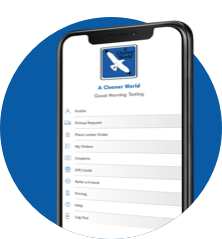A Cleaner World Blog
The pH Levels in your Laundry Products
I love when Gray comes home from school talking about something he’s learned. One of two things usually happen. Either it’s a topic that I remember, and we can have a nice conversation. Or, it’s something I remember but have completely forgotten about, and he has the chance to reeducate me. He likes that second thing.
Recently he got in the car talking about pH, and he did have to remind me that pH stands for “potential of hydrogen”, referring to the amount of hydrogen ions in a liquid solution. But then I surprised him by remembering that the numeric range is 0 to 14, the lower the number the more acidic the solution is, and the higher the number the more alkaline a solution is; seven is neutral. The interesting part about all of this is that pH is important when it comes to laundry, and here’s why. Alkaline solutions are better at tackling dirt, grease, proteins, and oils, while acids are better for removing calcium, rust, and other minerals. Knowing the pH of a product can come in very handy, so I decided to research common laundry products to find out their pH levels and how they do what they do.
pH Scale of Laundry Products
Baking Soda – pH 9
Lots of folks like to use baking soda as a household cleaner or as an additive in with their wash. Because it is an alkaline solution, it can be effective on grease and dirt while not being as harsh as bleach and Borax.
Borax – pH 10
While still on the alkaline side, Borax isn’t as corrosive as bleach but is just as good at breaking down oils and dirt. When used properly, Borax can be a helpful laundry tool.
Chlorine Bleach – pH 11-13
Because bleach is on the top end of the alkaline level, it’s harsh and requires proper handling. Use caution when using bleach because it’s not safe for some fabrics, but, on the other hand, when used properly it can be useful when dealing with stubborn stains.
Dish Detergent – pH 7
Many of us don’t think of dish detergent as a laundry aid, and while it is neutral, certain brands and types can be effective when it comes to removing oil-based or greasy stains and spills. Just place a small amount over the entire area and launder according to the care label’s directions (provided the garment is machine washable).
Laundry Detergent – pH 7-10
The pH of laundry detergent varies from brand to brand because manufacturers keep their exact formulas secret. Most detergents tend toward the higher end of the range because if they are too acidic, they could damage fabrics.
Vinegar – pH 3
We’ve often suggested using vinegar as a natural fabric softener, and here’s why. White distilled vinegar, with its mildly acidic pH, can dissolve leftover mineral deposits and soap residue, which is how your clothes end up feeling soft. It is also effective at removing and preventing mildew odors.
If you have a question about a laundry product, feel free to shoot me an e-mail at wildwednesday@acleanerworld.com or stop by one of our locations and speak with a manager. After all, they are certainly experts when it comes to this sort of thing.



